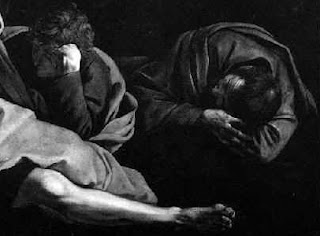On Tuesday mornings I meet with a group of men to read and reflect upon the next Sunday’s Gospel. Lots of the guys come looking for answers – like the disciples running to the tomb in this morning's Gospel. The guys take turns preparing a kind of study of the Gospel, to bring us into conversation about it. Tuesday it was Larry, a retired M.D., a Pathologist. Pathologists study the cause, method, structure, and consequence of disease. We need them to find answers. True to his trade, Larry looks in Scripture for answers: Here are the facts, here’s the analysis, here’s the result. He squirmed in his chair as he read John’s Gospel:
…he went into the tomb and saw the burial cloths there,
and the cloth that had covered his head,
not with the burial cloths but rolled up in a separate place.
Then the other disciple also went in,
the one who had arrived at the tomb first,
and he saw and believed.
For they did not yet understand the Scripture
that he had to rise from the dead.
The usually reverent, gentle, gray haired old man slumped in his chair, shook his head from side to side, And said disdainfully “well, now, that’s a heck of a Gospel; it just kind of leaves you hanging.” And so we are, aren’t we. There’s no big Ta-Daaaaaaaaaaaaaaah! Just a couple of burial garments in different parts of the tomb, one rolled up on the other side of the tomb. Jerusalem CSI!
Again I repeat Frederick Buechner’s repeated Big Question, asked here by most of us on Easter morning: Can it really be true? When we lived in Detroit, the Way of the Cross was all around us every day. To the skeptic the roles were reversed. It was the crowd that was carrying their crosses up the mountain, while Jesus stood to the side and looked on, or possibly wept. God seemed, sometimes, to have abandoned us. We who tried to live Christian lives sometimes felt overwhelmed by the demands of charity. The needs were so great in our poor, dear city. And so in Gesu Church there in the city, we identified with Holy Week, felt it as our own. Good Friday put us into a real darkness, and we longed for Easter. We dared to hope that somehow things might change, that God would find a way for our city.
Holy Saturdays have always been long for me. As a kid, I would spend them looking longingly at my still-cellophane-wrapped Easter basket. As a working person, I would itch to treat the day like one to get projects done, to be worldly and set Lent aside. But on Holy Saturday 1999 there I sat with the ache. In my heart and in my soul and on my mind one thought possessed me:“I need you risen!” It had entered me as I walked out of the quieted church at 3:00 on Good Friday, the bell tolling slowly into a neighborhood suddenly on its knees. I wept flaccid tears in bed that Holy Saturday night, repeating those words as a prayer, a glossolalic litany. “I need you risen; I need you risen; I need you risen….”
It was a warm night, one of the first of the spring when the bedroom window could be cracked open, to let in fresh air. I slept poorly, partially because of that open window, and the way sounds from the street made their way into the bedroom. When I’d stir, I’d think of the waiting that the disciples did, the lostness, the despair, and I’d repeat my plea: “I need you risen!”
And then, hours before sunrise and before any distinguishable hint of light in the eastern sky, a robin began singing in the tree just outside our window. He sang a song of joy. Despite the lack of substantial evidence, he knew.
Hope
Oh! Easter morn's elusive flight
From hearts whose hope is almost gone!
Oh, Oedipal eyes' mad grope for light
'Mid nightmares of the gibbet's Pawn!
Good Friday vespers' echoes fill
The heart weighed down by reverenced cross,
And redolent incense lingers still
In Friday's garments' listless toss.
Yet through night's window sweet confection
Penetrates the curtains drawn,
As robin sings of Resurrection
Long before the hint of dawn.
April 2, 1999…Easter



















